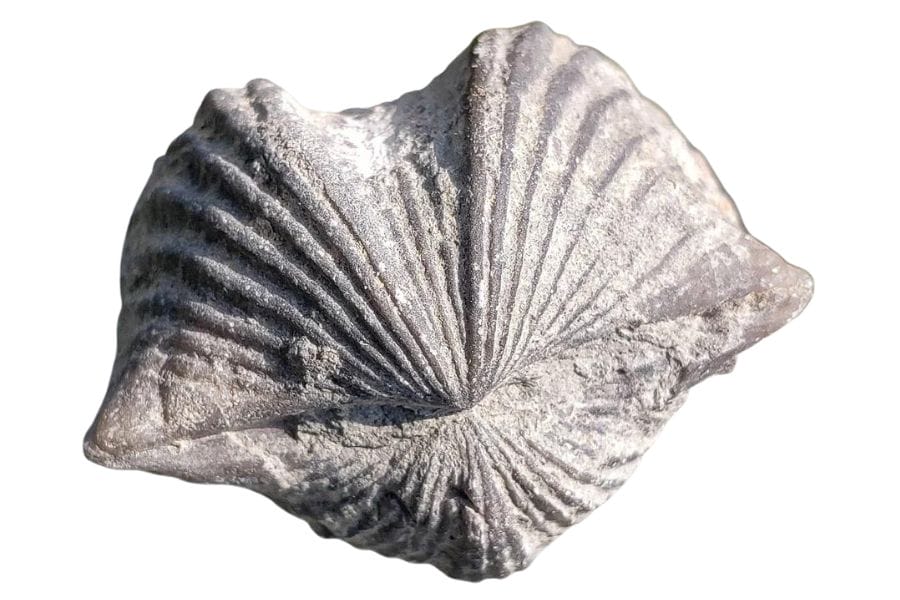Nevada, often recognized for its bustling cities and vast deserts, is also home to a rich tapestry of fossils that tell the story of a bygone era. In various terrains, the state hides clues about creatures that once roamed its land and waters.
These Nevada fossils range from marine species that swam in prehistoric seas to plants that adorned its landscapes, and from mammals that treaded its terrains to even some incredible dinosaur fossils.
With so many types of fossils spread across varied terrains, the state offers a captivating journey into the past for fossil enthusiasts and those eager to understand Earth’s history.
The Fossils Of Nevada You Can Find
In different areas around Nevada, you might come across the spiral shells of ammonites or the segmented bodies of trilobites. Brachiopods, with their unique shell designs, also once called this area home.
Beyond marine life, plant fossils give a peek into the greenery that dotted the land. Dig deeper, and you might discover the bones of ancient mammals. Even some impressive dinosaur bones have been uncovered in this state.
For those interested in more than just fossils, we also have a guide that can help you find rocks and minerals in Nevada. This guide provides details on where to search for other fascinating rocks, minerals, and gems scattered across the state.
- The extensive local experience and understanding of our team
- Input from multiple local fossil hunters and fossil groups
- The accessibility of the various locations
- Safety and potential hazards when collecting
- Private and public locations
- A desire to include locations for both experienced fossil lovers and those who are just starting out
Using these weights we think we’ve put together the best list out there for those who love finding great new fossils for our collections!
Common Nevada Fossils
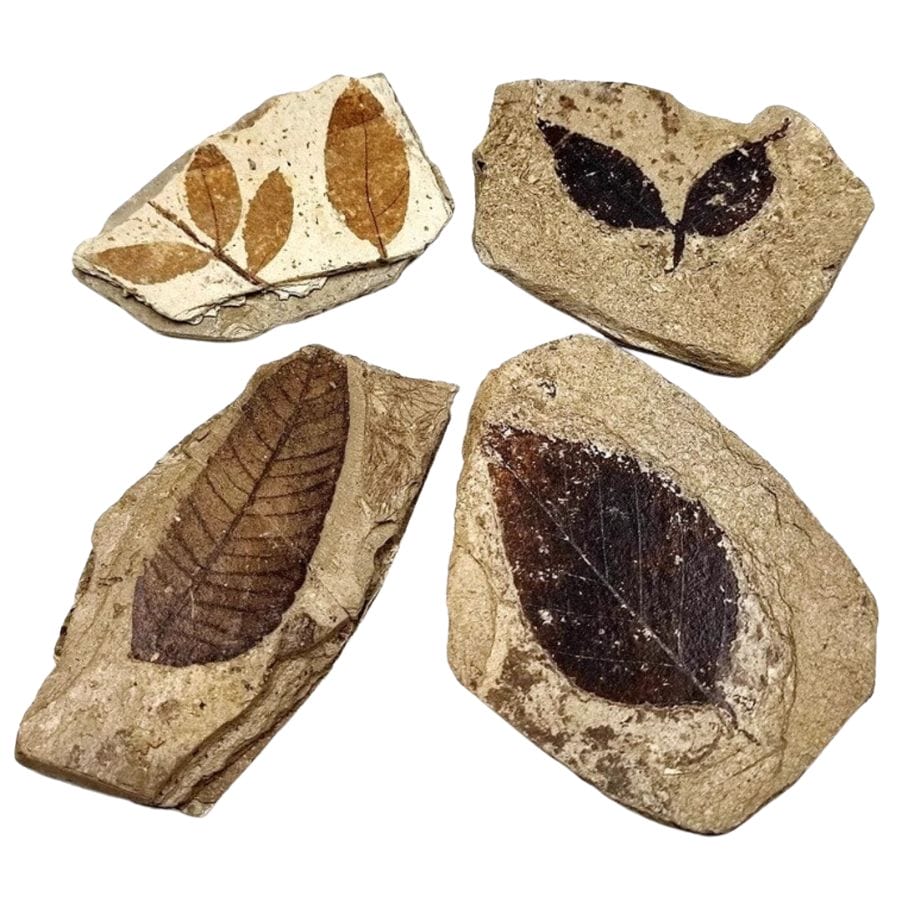
From sea creatures to plants, the variety of fossils that can be found in Nevada is truly astounding. Here’s a list of some common fossils that eager seekers might come across in this state.
- Plant fossils
- Trilobites
- Corals
- Ammonites
- Brachiopods
- Sponges
Nevada State Fossil – Ichthyosaur
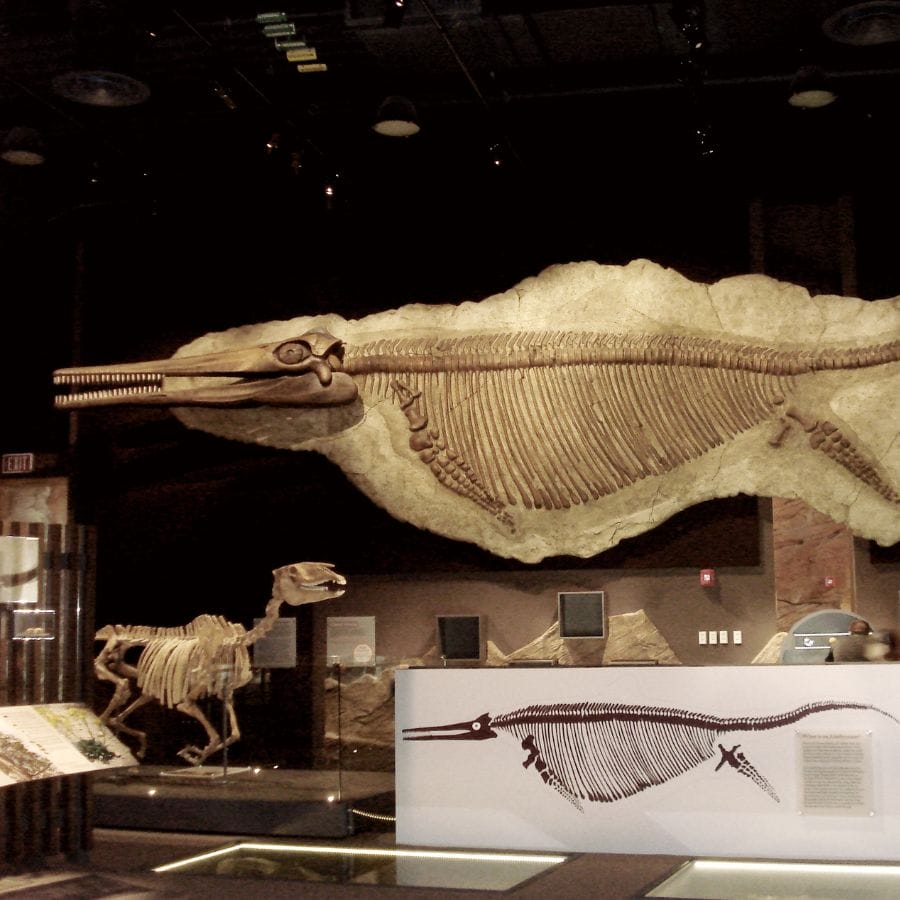
Ichthyosaurs were marine reptiles that lived millions of years ago. They looked a bit like dolphins of today, but they weren’t related to them.
These creatures had sleek bodies, long snouts filled with sharp teeth, and big eyes, which suggests they might have hunted in deep, dark waters. Their fins and tails helped them swim fast, making them skilled hunters of the sea.
Ichthyosaurs also gave birth to live young, which is rare for reptiles.
Over time, they changed in size and shape, with some growing as large as modern-day whales.
Rare Nevada Fossils
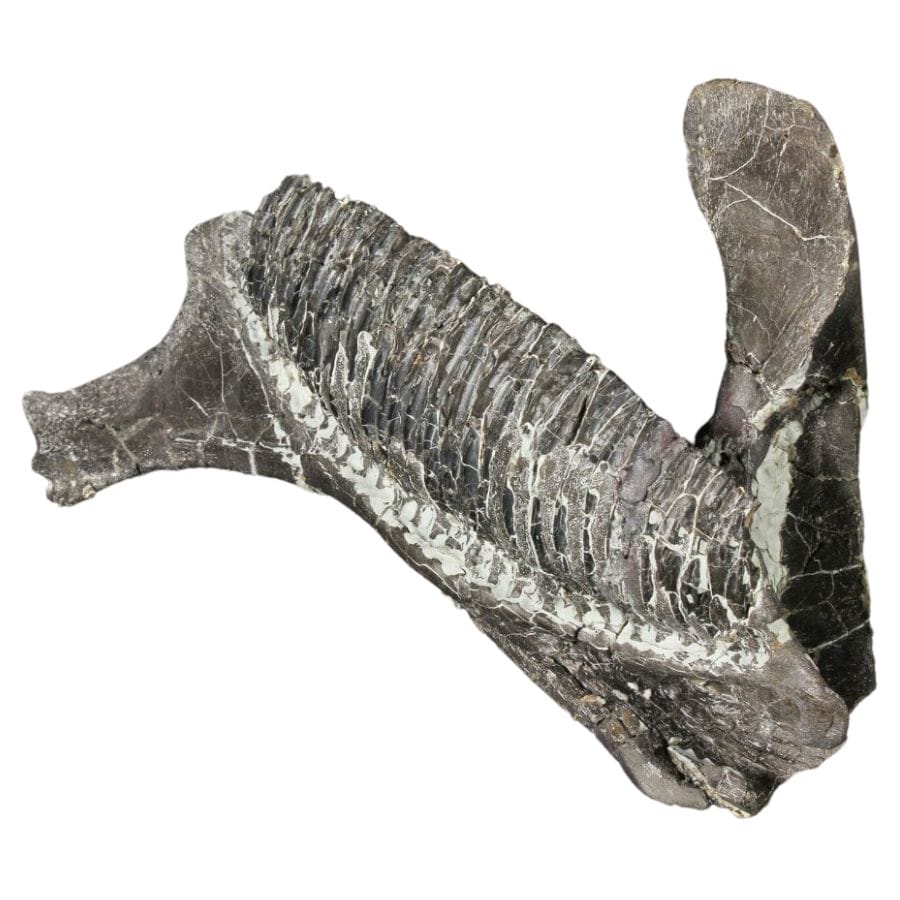
Nevada is home to some truly unique finds in the world of paleontology. Among these treasures are the valuable rare Nevada fossils that have caught the attention of enthusiasts worldwide:
- Dinosaur bones and teeth
- Mammal bones
The Best Places To Find Fossils In Nevada
From valleys to mountains, Nevada has a rich geological history waiting to be discovered. Let’s dive into the top locations where you can uncover various kinds of fossils in the state.
Always Confirm Access and Collection Rules!
Before heading out to any of the locations on our list you need to confirm access requirements and collection rules for both public and private locations.
These requirements are subject to change without notice and may differ from what we state below.
Always get updated information directly from the source ahead of time to ensure responsible rockhounding.
Berlin-Ichthyosaur State Park
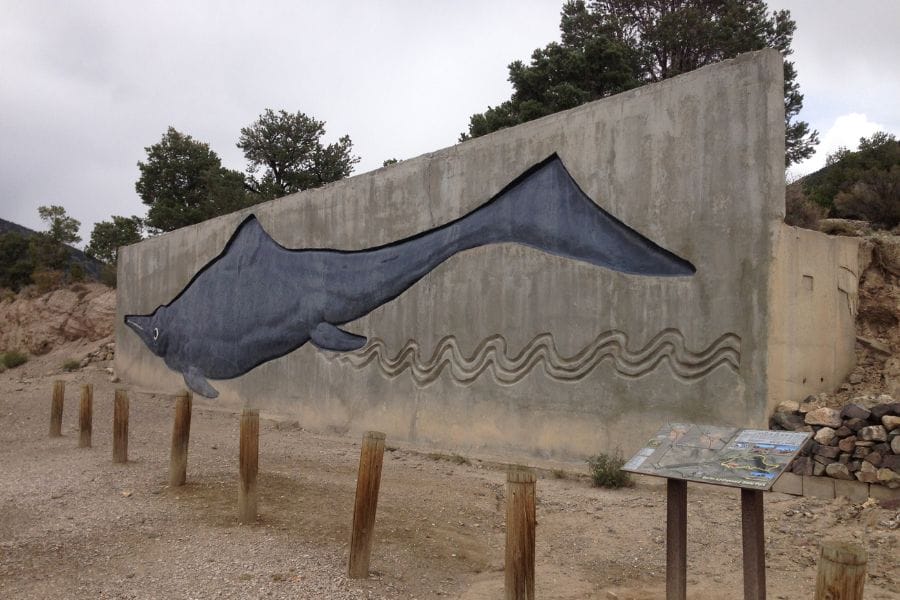
The Berlin-Ichthyosaur State Park covers over 1,100 acres of rolling hills, vast open spaces, and rugged terrain. One of its main attractions is the fossils of Nevada’s marine reptiles known as ichthyosaurs.
These creatures, resembling modern dolphins, once swam in seas that covered this area.
The park’s geology is a mix of sedimentary rocks, which are layers of stone that formed from tiny bits of plants, animals, and sand settling down in quiet waters.
Over time, these layers turned into rock, preserving the remains of the ichthyosaurs. The terrain here has been shaped by both natural forces and human activity.
Mining was once a big part of the area, and remnants of the old mining town of Berlin can still be seen today.
Where to find fossils in the Berlin-Ichthyosaur State Park
The Berlin-Ichthyosaur State Park is known for its ichthyosaur fossils, large marine reptiles that once swam in the waters covering Nevada. These ichthyosaur bones are mainly located within the park’s exposed rock formations.
Besides ichthyosaurs, you might also find fossils of other marine creatures in the limestone layers.
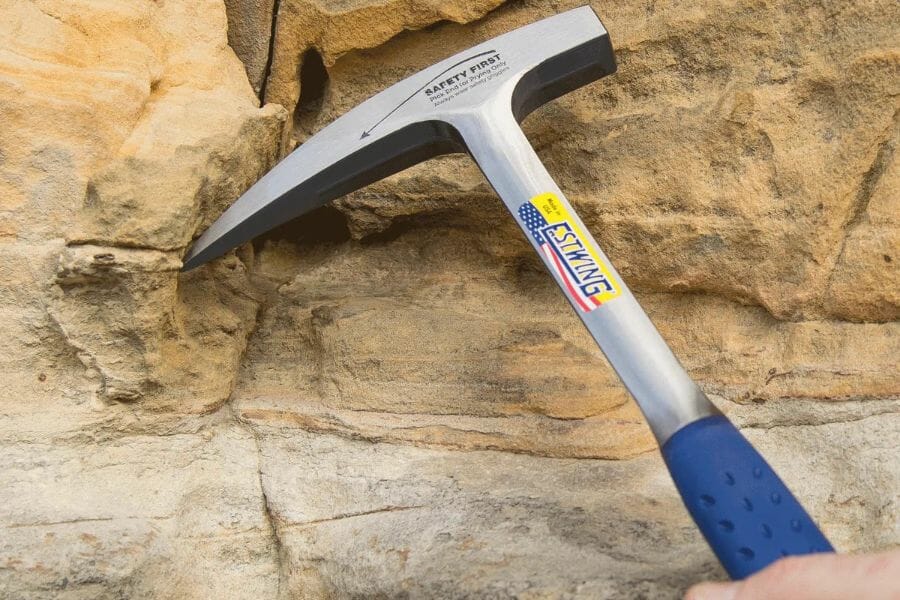
The tools every fossil hunter will need
When you're out looking for fossils having the right tools for the job is really going to make or break your success. You don't need a lot for most trips but there are a handful that are critical and will make your life a lot easier.
We get asked a lot about the equipment we use. Over the years we've found a handful of tools that we recommend to both new and experienced fossil hunters which we outline in great detail in our complete rockhounding tools and kit guide. These are quality options that also happen to be relatively inexpensive.
Below are the basic tools that make your life so much easier and save you a ton of time. Check out the full guide to see everything we recommend bringing. One quick note, as an Amazon Associate I earn from qualifying purchases but we try very hard to only recommend gear we would use ourselves and often recommend brands you can't find on Amazon.
At a minimum you should have:
1 - Sturdy rock hammer: The Estwing Rock Pick is our standard
2 - Rugged chisels: Try Kendo' 3-piece Chisel Set
3 - Compact shovel: The Koleiya 28-inch shovel works well
4 - Rock screen pan: The Wazakura Soil Sieve Set fits the bill
5 - Eye protection: DeWalt Safety Glasses are cheap and comfortable
6 - Head protection: Malta's Safety Helmet has been our go-to
7 - Jewelers lens with at least 20x magnification: Jarlink's Jewelers Loop is perfect
The fossil-finding books that we use most
There are also a few books that have been extremely helpful in the search for gems. These books have great recommendations and tips:
National Audubon Society Field Guide to Rocks and Minerals: North America
Southwest Treasure Hunter's Gem & Mineral Guide
Earth Treasures: The Southwestern Quadrant
We provide links to find these tools on Amazon but some can also be found at your local hardware stores. For more recommendations check out the link to our full tool guide above.
Tule Springs Fossil Beds National Monument
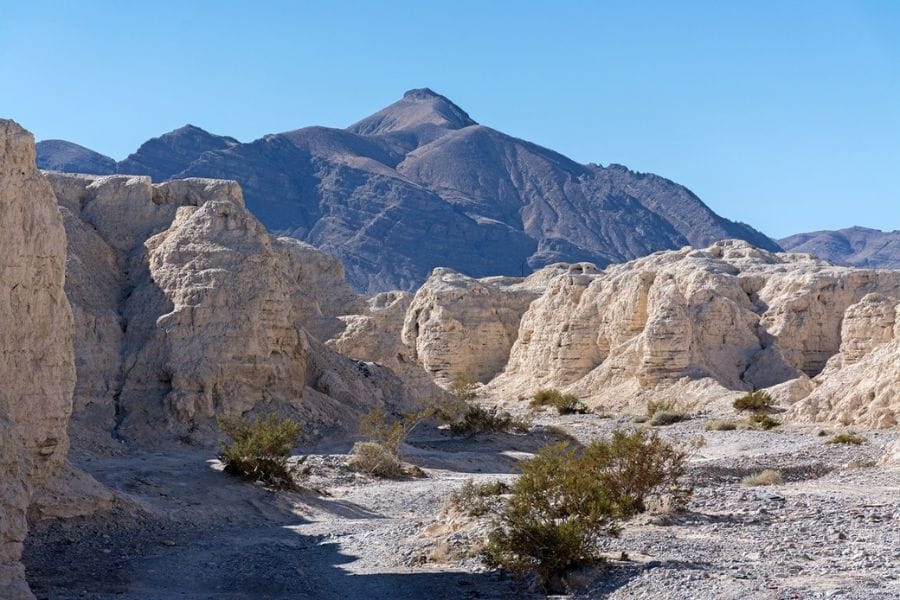
The Tule Springs Fossil Beds National Monument boasts a rich tapestry of sedimentary rock layers that offer clues about the creatures that once roamed here.
As you wander through its varied terrain, you’ll find a mix of rolling hills and vast basins, each telling a unique story. Among the rock formations and fossil beds, you’ll discover some of the most intriguing fossils in Nevada.
The geology of the area paints a vibrant picture of life from thousands of years ago. Exploring this area is like flipping through the pages of a captivating book, revealing the wonders of our planet’s past.
Where to find fossils in the Tule Springs Fossil Beds National Monument
Tule Springs Fossil Beds National Monument is home to fossils of animals from the Ice Age. Within the sedimentary rock layers, you can find remains of mammoths, camels, and even big cats like lions.
These fossils are most commonly found where erosion has exposed older layers, particularly in areas with visible rock outcroppings.
Red Rock Canyon National Conservation Area
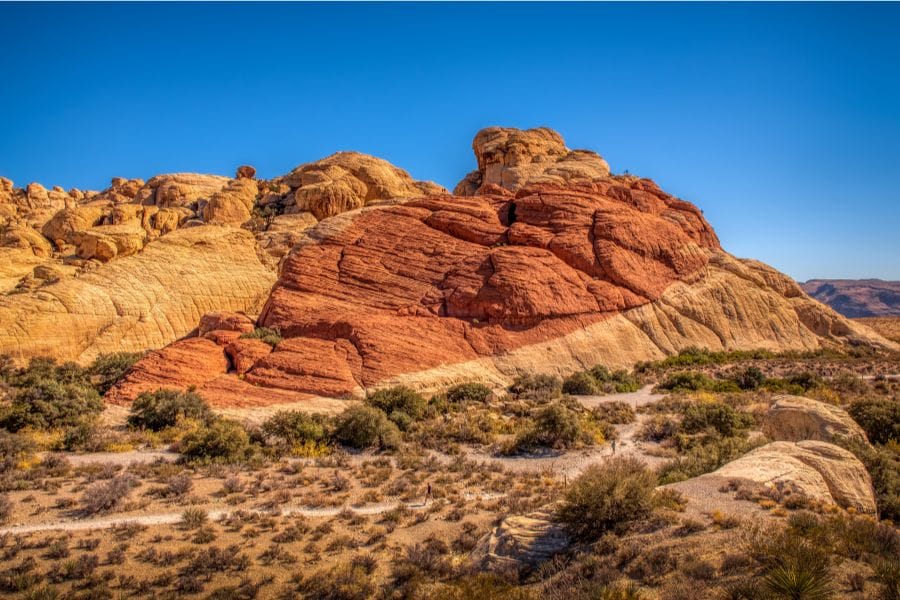
The main attraction of the Red Rock Canyon National Conservation Area is the vibrant red and orange sandstone cliffs that soar high into the sky.
These colorful formations are the result of layers upon layers of sediment compacted over millions of years.
As you explore the area, you’ll also come across massive limestone peaks and unique desert plants. The terrain varies from rugged canyons to wide-open plains, each area offering its own set of rock formations and histories.
While the rocks are captivating, you can also discover common Nevada fossils that give a glimpse into the life that once thrived here. From tiny sea creatures to large mammals, the area has preserved evidence of a diverse ecosystem.
Where to find fossils in the Red Rock Canyon National Conservation Area
The Red Rock Canyon National Conservation Area is home to marine fossils, as this area was once covered by a deep sea. If you explore the limestone formations, you’ll likely spot fossilized shells and small sea creatures.
The Calico Hills and Keystone Thrust areas of the park are particularly good spots to see these preserved shells and marine life.
Valley of Fire State Park
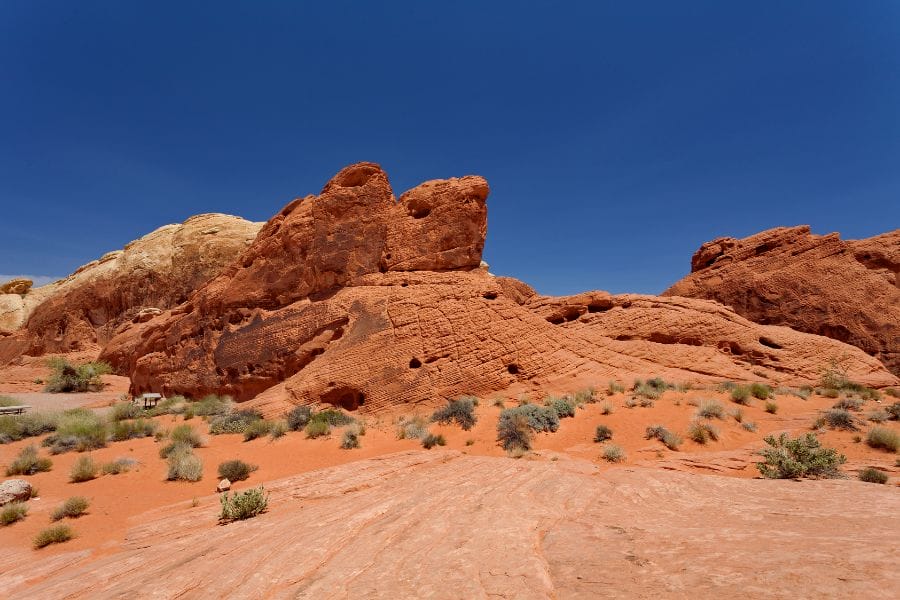
The Valley of Fire State Park is a stunning area known for its fiery red sandstone formations. These rocks light up with a radiant glow, especially during sunrise and sunset, making the park’s name very fitting.
Formed millions of years ago, the vibrant sandstone tells tales of shifting dunes and changing environments. Erosion by water and wind has molded these rocks into captivating shapes, including arches, pillars, and canyons.
The park covers a vast expanse with a diverse range of terrains, from rugged rocky outcrops to open valleys. These terrains hold a wealth of geological stories waiting to be explored.
For those interested in fossil hunting in Nevada, this park presents an exciting opportunity. Various fossilized remains, from plants to small creatures, are embedded in the rocks within the park.
Where to find fossils in the Valley of Fire State Park
In the Valley of Fire State Park, you can discover marine fossils, including shells and corals. These fossils are primarily located within the park’s limestone deposits. Sandstone areas of the park might also contain impressions left by small critters.
Spring Mountains
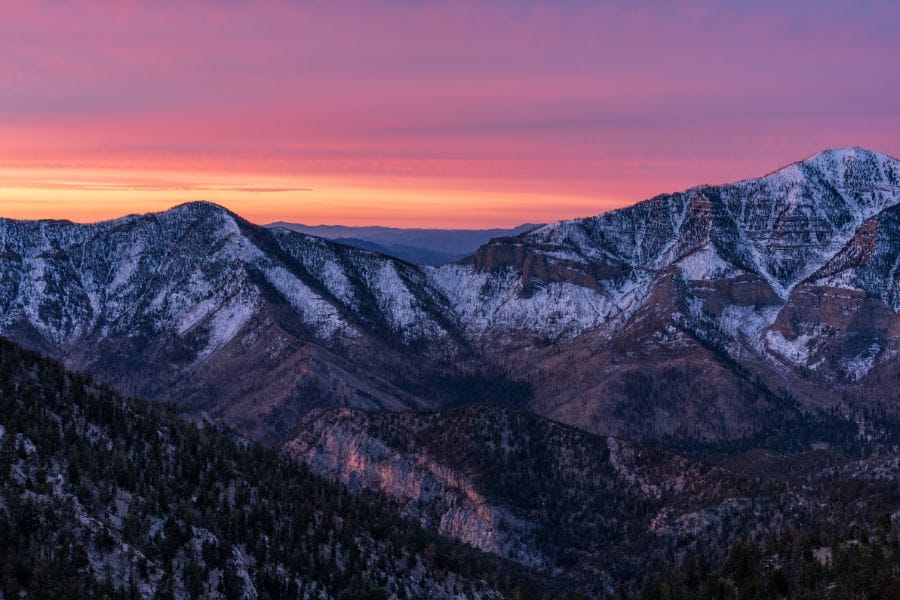
The Spring Mountains are a remarkable range, rising majestically and offering a striking contrast to the surrounding desert landscapes. These mountains have peaks that soar to impressive heights, with the tallest reaching over 11,000 feet.
The terrain here is diverse, encompassing dense forests, open meadows, and rocky outcroppings. Water flows in sparkling streams, nourishing the varied plant and animal life.
Geologically, the Spring Mountains are made up of layers upon layers of rock, each telling a unique story of the Earth’s past. These rocks have witnessed countless changes over the eons, from shifting tectonic plates to the evolution of life.
Among these layers, one can find different kinds of fossils of Nevada, giving insights into the creatures that once inhabited this region.
Where to find fossils in Spring Mountains
In Spring Mountains, you can find marine fossils such as trilobites and brachiopods. These fossils are mostly spotted in the limestone areas of the mountains.
Another spot to look is in the shale layers, where some plant fossils might be hidden.
Other Top Places To Find Nevada Fossils By Region
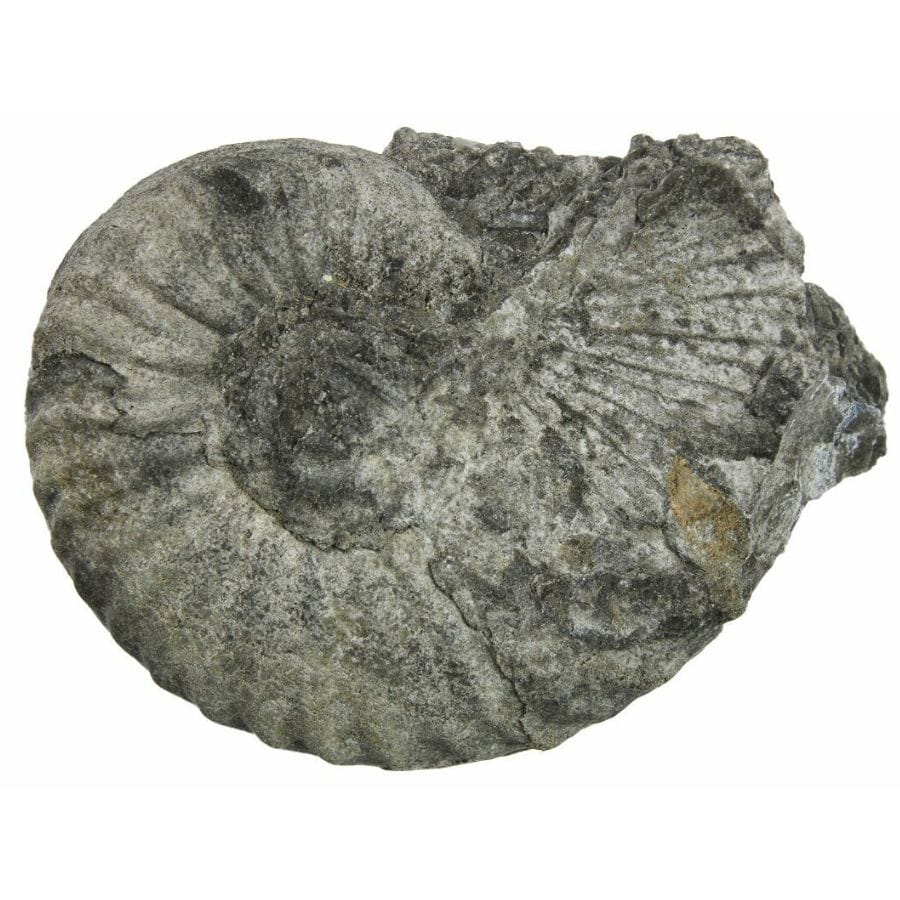
From mountains to valleys, there are special spots in Nevada where fossils are known to be found. If you’re keen to discover these fascinating fossils, here’s a list of areas you might want to check out.
| Location | Fossils |
| Buffalo Canyon, Churchill County | Plant fossils |
| Clan Alpine Mountains, Churchill County | Plant fossils |
| Middlegate Hills, Churchill County | Red fir seeds, tanoak leaves, willow |
| Soda Lake, Churchill County | Reeds, seaweeds |
| Arden, Clark County | Pelecypods |
| Sheep Mountains, Clark County | Trilobites, brachiopods |
| Crittenden Springs, Elko County | Ammonites |
| Deeth, Elko County | Dicranograptus, Diplograptus, Climacograptus |
| Elko, Elko County | Moropus |
| Jarbridge Junction, Elko County | Leaves, twigs, seeds |
| Montello, Elko County | Juvenites, Owenites, Parannanites, Pseudosageceras, Meekoceras, Flemingites, brachiopods |
| Pinyon Range, Elko County | Brachiopods, bryozoa |
| General Thomas Hills, Esmeralda County | Graptolites, Olenellus, Glyptograptus, Amplexograptus, Orthograptus, Dicranograptus, Climacograptus, Paedeumias, Climacograptus, Orthograptus, Dicranograptus, Caryocaris |
| Gold Point, Esmeralda County | Judomia, brachiopods, small bivalves, Laudonia, Nevadia, Ethmophyllum, Fremontia, Nevadella, Holmia, Olenellid trilobite, Salterella, Bonnia, Oryctocephalus, Athabaskia |
| Goldfield Hills, Esmeralda County | Paedeumias, Crassifimbra, Archeocyathids, Alokistocare, Syspacephalus, Hyolithes, Caryocaris, fragments of meristome chelicerates, Dictyonema, sponge spicules, trilobites, Oryctocephalus, Alokistocare, Olenellus cephalons |
| Montezuma Peak, Esmeralda County | Bryograptus, Clonograptus, Holmia, Nevadella, Laudonia, Climacograptus, Glyptograptus, Didymograptus, Orthograptus, Olenellus, Ptychoparid trilobites, Paedeumias, Dicellograptus, Dicranograptus, Retiograptus, Caryocaris |
| Mount Dunfee, Esmeralda County | Algal masses and structures, trilobites, brachiopods, Archeocyathids |
| Paymaster Canyon, Esmeralda County | Olenellus, O Gilberti, Paedeumias, O fremonti, Climacograptus, Glyptograptus, Ogygopsis, Bonnia, Acanthopsis, Ptychoparid, Cardiograptus, Isograptus, Phyllograptus, Tetragraptus, Antagmus, Fremontia, Scenella, Holmia |
| Silver Peak Range, Esmeralda County | Judomia, Laudonia, Climacograptus, Orthograptus, Glyptograptus, Diplograptus, Glossograptus, Dicellograptus, brachiopods, Chancelloria spines, dorypygid trilobite |
| Atrypa Peak, Eureka County | Stromatopora, Favosites, Pachyphyllum, Zaphrentis, Lingula, Orthis, Chonetes, Stropheodonta, Productus, Spirifer |
| Brush Peak, Eureka County | Stromatopora, Favosites, Pachyphyllum, Zaphrentis, Lingula, Orthis, Chonetes, Stropheodonta, Productus, Spirifer |
| Carlin, Eureka County | Bird bones |
| Combs Mountain, Eureka County | Stromatopora, Favosites, Pachyphyllum, Zaphrentis, Lingula, Orthis, Chonetes, Stropheodonta, Productus, Spirifer |
| Lone Mountain, Eureka County | Receptaculites, Monticulipora, cystoids, Acrotreta, Strophomena, Modiolopsis, Helicotoma, Pleurotomaria, Murchisonia |
| Prospect Peak, Eureka County | Olenellus, Anomalocaris, Olenoides, Scenella, Kutorgina, Ptychoparia, Olenellus, Peachella |
| Richmond Mountain, Eureka County | Zaphrentis, Fenestella, Lingula, Discina, Streptorhynchus, Chonetes, Productus, Spirifera, Terebratula, Aviculopecten, Myalina, Bellerophon |
| Buena Vista District, Humboldt County | Myacites, Corbula, Halobia |
| Humboldt City, Humboldt County | Rhynchopterus, cephalopods |
| McDermitt, Humboldt County | Petrified wood |
| Sierra District, Humboldt County | Nautilus, Mytilus, Myophoria |
| Thousand Creek, Humboldt County | Ilingoceros, Osteoborus, Sphenophalos |
| Comet Mine, Lincoln County | Oryctocephalites, Eokochaspis, brachiopods, hyolithids, anamalocarids, Canadaspis, Tuzoia |
| Golgatha Hill, Lincoln County | Mammal bones |
| Highland Range, Lincoln County | Callavia, Olenellus, Crepicephalus |
| Klondike Gap, Lincoln County | Eokochaspis, Albertella, Albertellina, Nyella, Panacus, Ptarmiganoides |
| Panaca, Lincoln County | Felis, Canis, Borophagus, Bassariscus, Notiosorex, Prodipodomys, Ondatra, Repomys, Neotoma, Mimomys, Ophiomys, Hypolagus, Lepoides, Pewelagus, Nekrolagus, Perognathus, Dinohippus, Equus, Platygonus, Megatylopus, Hemiauchenia, Oreamnos |
| Pioche, Lincoln County | Eocystites, Linguella, Kutorgina, Hyolithes, Ptychoparia, Zacanthoides, Bathyuriscus, Acrothele, Orthis, Olenellus, Olenoides, Crepicephalus, Oryctocephalus |
| Rachel, Lincoln County | Fish fossils |
| Spring Valley, Lincoln County | Mammal bones |
| Smiths Valley, Lyon County | Citellus, Pliosaccomys, Pliozapus, Peromyscus, Osteoborus, Indarctus, Pliomastodon, Pliohippus, Aphelops, Prosthennops, Paracamelus |
| Yerington, Lyon County | Plant fossils |
| Candelaria, Mineral County | Graptolites, ammonites, pelecypods, Linoproductus, Neospirifer, Punctospirifer, Pugnoides, Chonetes |
| Gabbs Valley Range, Mineral County | Choristoceras, Arcestes, Pinacoceras, Sagenites, Endoceras, Coroniceras, ammonites, Euphyllites, Psiloceras |
| Hawthorne, Mineral County | Petrified wood |
| Luning, Mineral County | Pelecypod, corals, Spiriferina, Terebratula, ammonites |
| Stewart Valley, Mineral County | Plant fossils |
| Ickes Canyon, Nye County | Brachiopods, trilobites, sponges, ostracods, conodonts, bryozoa, pelecypods, cephalopods, gastropods |
| Johnnie, Nye County | Cloudina, Nimbia |
| Monitor Range, Nye County | Conodonts, brachiopods, trilobites |
| Tonopah, Nye County | Tomarctus |
| Virginia City, Storey County | Plant fossils |
| Pyramid Lake, Washoe County | Birch, alder, cottonwood, willow, maple, fir, spruce, Douglas fir, pine |
| Truckee River Canyon, Washoe County | Chloropagus, seeds, leaves |
| Cathedral Canyon, White Pine County | Alveolites, Radiastraea, Atrypa, Spongophyllum, Amphipora, Productella, Leptaena, Chonetes, Schuchertella, Reticulariina, Orthothetes, Productina, echinoid plates, Spirifer, Linoproductus, Aviculopecten |
| Eberhardt, White Pine County | Spirifer, Linoproductus, Aviculopecten, Composita, Cleiothyridina, Reticulariina, Eumetria, Dictyoclostus, Mooreoceras, Cravenoceras, Epicanites, Dimorphoceras |
| Hamburg Ridge, White Pine County | Lingula, Lingulepis, Discina, Acrotreta, Schizambon, Obolella, Orthis, Triplesia, Tellinomya, Dikelocephalus, Ptychoparia, Amphion |
| Pogonip Ridge, White Pine County | Linguelepsis, Lingula, Obolella, Acrotreta, Leptaena, Agnostus, Ptychoparia, Arethusina |
| Seligman Canyon, White Pine County | Dunderbergia, Elvinia, Pseudagnostus, Pterocephalia, Acrotreta, Irvingella, Berkeia |
| Smith Creek Canyon, White Pine County | Mammal and vulture bones |
Common Questions About Fossil Hunting In Nevada
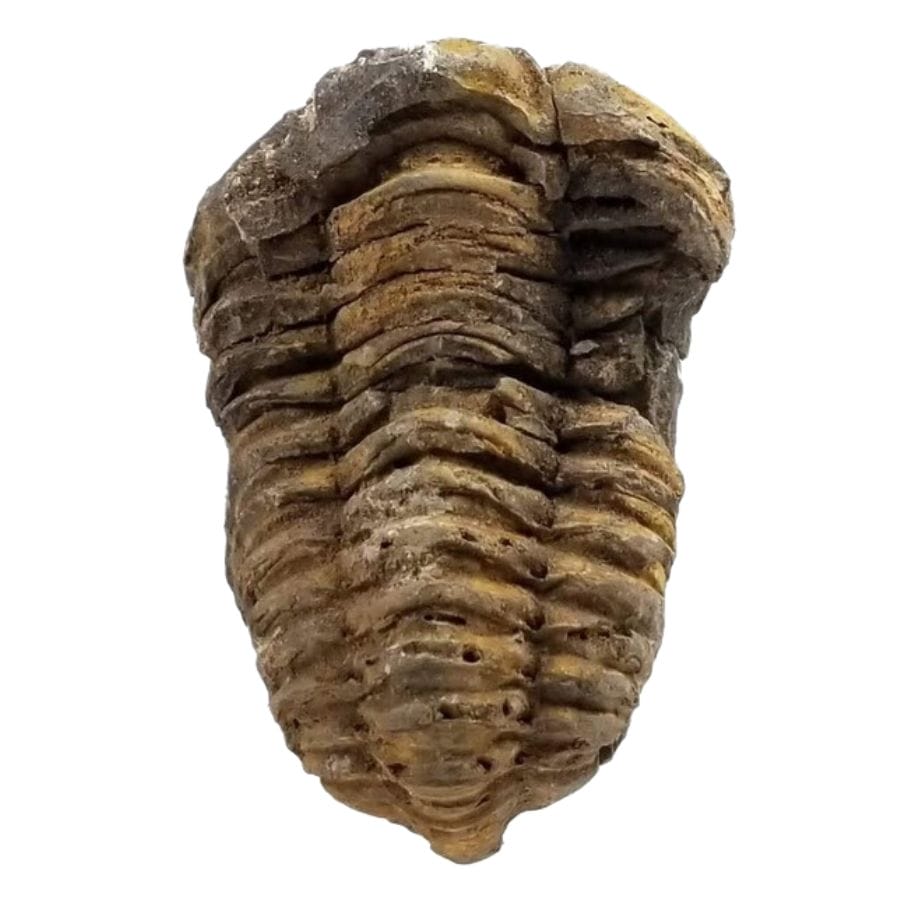
There’s so much to learn and discover about the world of fossils. From identification to locations, folks have a lot of burning questions. Let’s dive into some of the most commonly asked ones and uncover the answers!
Can you find megalodon teeth or shark teeth in Nevada?
A long time ago, parts of Nevada were covered by oceans and seas. This means that some ocean creatures, like sharks, lived in these waters. Today, we can find evidence of this past life in the form of fossils in Nevada.
However, megalodon teeth specifically have not been widely reported from this region. The types of shark teeth that might be discovered are from different species that once swam in the area.
Is it illegal to collect fossils in Nevada?
In Nevada, there are some rules that you have to follow when it comes to collecting fossils. It’s essential to know that not all fossils can be picked up and taken home.
On federal lands, it’s illegal to collect vertebrate fossils (like dinosaur bones) without a permit.
However, you can collect a reasonable amount of common invertebrate and plant fossils for personal use. If you’re on state lands or parks, different rules might apply, and collecting could be restricted.
You can check with government agencies like the Nevada Bureau of Land Management for more information.
Private lands have their own set of guidelines; you need the landowner’s permission to collect anything. It’s always a good idea to check with local land management agencies or park offices before starting your fossil hunt.
Can you find dinosaur bones in Nevada?
During the time of the dinosaurs, most of Nevada was underwater, covered by a warm, shallow sea. This means instead of land-dwelling dino fossils, you’re more likely to come across marine fossils like ammonites or trilobites.
Now, this doesn’t mean dinosaur bones are entirely absent from the state. A few scattered finds have hinted at their presence. Still, these are not as common as the marine fossils.
It’s important to know that while it’s possible to find dinosaur bones in Nevada, they are rare.
How do you identify the fossils that you find?
When you find a fossil, first look at its shape and size. Different animals have unique bone structures, so a little research can help you match your find with pictures in fossil guidebooks or reliable online sources.
Next, consider the type of rock where you found the fossil. Certain fossils are more common in specific rock types. For example, limestone often holds marine creature fossils because it formed under the sea.
It’s also helpful to know the history of the area you’re exploring. If you’re aware of the creatures that once lived there, it can narrow down your options.
Our Favorite Places To Buy Fossils In Nevada

If you’re excited about fossils, Nevada has some awesome spots to shop! Whether you’re a seasoned collector or just starting out, there’s something for everyone. Here’s a list of top places to begin your fossil shopping adventure:
- Jewelry & Minerals of Las Vegas – 410 E Sahara Ave, Las Vegas, NV 89104
- Earthe Energe – 1023 Rock Blvd A, Sparks, NV 89431
- Rockchuck Gem and Mineral Gallery – 4045 South Highway 95, Schurz, NV 89427
- Silver Post – 1875 Festival Plaza Dr Suite 150, Las Vegas, NV 89135
- Cabin Creek Crystals – 770 S Virginia St, Reno, NV 89501

